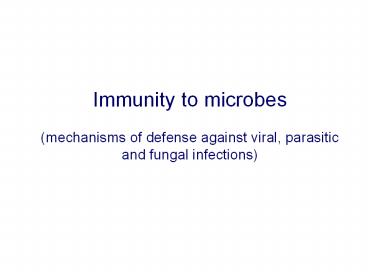Immunity to microbes - PowerPoint PPT Presentation
1 / 37
Title:
Immunity to microbes
Description:
Title: Slide 1 Author * Last modified by: Taja Created Date: 10/7/2003 8:34:20 AM Document presentation format: On-screen Show (4:3) Company: IBISS – PowerPoint PPT presentation
Number of Views:140
Avg rating:3.0/5.0
Title: Immunity to microbes
1
Immunity to microbes (mechanisms of defense
against viral, parasitic and fungal infections)
2
Goal
To understand basic principles of defense
against infections induced by
bacteria - extracellular - intracellular
viruses
- parasites
- protozoa
- helmints
fungi
3
Viruses
Simple structure (subcellular level)
Obligate intracellular agents
- unable to replicate outside cells
- enter cells via receptors
Induce diseases through
- damage of cells in which they replicate
- induction of immune response
Infections
- acute
- chronic (active and latent)
4
Mechanisms of defense against viruses
Mechanisms of innate immunity
- inhibition of infection and induction of
antiviral state - type I interferons (IFN-a and ß)
- killing of infected cells (NK cells)
5
Antiviral action of type I interferons
Uninfected cells
Infected cells
Expression of enzimes that inhibit viral
replication
Protection from infection
Killing of infected cells by CTLs
6
Destruction of infected cells by NK cells
7
Destruction of infected cells by NK cells
8
Destruction of infected cells by NK cells
9
Mechanisms of defense against viruses
Mechanisms of adaptive immunity
Humoral immunity
B cells and antibodies
- neutralization (IgG and IgA), ADCC (IgG) and
opsonization (IgG)
Cell-mediated immunity
10
Neutralization of viruses
11
Protective mechanisms of antibodies
12
Mechanisms of defense against viruses
Mechanisms of adaptive immunity
Humoral immunity
B cells and antibodies
- neutralization (IgG and IgA), ADCC (IgG) and
opsonization (IgG)
Cell-mediated immunity
CD8 and CD4 T cells
- killing of infected cells (CD8 T cells)
- activation of CD8 T cells and and B cells
(CD4 helper T cells)
13
Mechanism of killing by CTLs
14
Mechanism of killing by CTLs
15
Mechanism of killing by CTLs
16
Mechanism of killing by CTLs
17
Mechanism of killing by CTLs
18
Mechanism of killing by CTLs
granzymes
perforin
Target cell
CD8 CTL
19
Mechanism of killing by CTLs
Target cell
CD8 CTL
apoptosis
FasL
Fas
20
Mechanisms of innate and adaptive immunity
against viruses
21
Mechanisms of defense against viruses
Mechanisms of immune evasion
- antigenic variation (influenza virus, HIV...)
22
Antigenic variations of influenza virus
23
Mechanisms of defense against viruses
Mechanisms of immune evasion
- antigenic variation (influenza virus, HIV...)
- inhibition of antigen processing and
presentation (many viruses)
24
Inhibition of antigen processing and presentation
by viruses
25
Mechanisms of defense against viruses
Mechanisms of immune evasion
- antigenic variation (influenza virus, HIV...)
- inhibition of antigen processing and
presentation (many viruses)
- inhibition of immune response (many viruses)
26
Inhibition of immune response through production
of virokines and viroreceptors
27
Mechanisms of defense against viruses
Mechanisms of immune evasion
- antigenic variation (influenza virus, HIV...)
- inhibition of antigen processing and
presentation (many viruses)
- inhibition of immune response (many viruses)
- infection of immune cells (HIV...)
- establishment of latency (HSV, HIV...)
- inhibition of apoptosis (Herpes and Pox
viruses...)
28
Mechanisms of defense against viruses
Injurious effects of immune response
- tissue damage due to CD8 CTL activity (HBV...)
- immune complexes formation (HBV...)
- molecular mimicry (many viruses and various
autoimmune diseases)
29
Parasites
- complex eukaryotic organisms
- most common infectious diseases (30 of world
population)
- complex life cycles
- protozoa (unicellular) intra- and
extracellular agents
- helmints (multicellular warms) extracellular
agents
- often induce chronic infections
- constant exposure (endemic areas)
- direct exposure or via vectors
- need for vaccines (immunoparasitology)
30
Mechanisms of defense against parasites
Mehanisms of innate immunity
Protozoa and helmints mostly resistant
- complement and phagocytosis (protozoa)
- eosinophils and macrophages (helmints)
31
Mechanisms of defense against parasites
Mehanisms of adaptive immunity
Protozoa
B-cells, CD4 TH1 and CD8 T cells
- antibodies (B-cells) Entamoeba sp.,
Plasmodium sp.
- IFN-? production and macrophage stimulation
(CD4TH1 cells) - Leishmania sp.
- cytotoxicity (CD8 T cells) Plasmodium sp.
Helmints
B-cells and CD4 TH2 cells
- stimulation of B-cells to produce IgE (IL-4)
- stimulation of eosinophils (IL-5 and IgE)
- degranulation of mast cells (IgE)
32
Immunity against helmints (TH2 response)
33
Immunity against helmints (function of
eosinophils)
34
Mechanisms of defense against parasites
Injurious effect of immune response
- granuloma formation and fibrosis (Schistosoma
sp.)
- immune complex formation (Plasmodium sp.)
Mechanisms of immune evasion
- existence of different forms/stages (Plasmodium
sp...)
- alteration of surface antigens (Trypanosoma
sp....)
- complement resistance (many parasites)
-concealing cysts (Toxoplasma sp.), residence
in gut (intestinal parasites)
35
Fungi
- extracellular agents
- (some survive phagocytosis)
- yeast (unicellular)
- molds (multicellular)
- local and systemic mycoses
- most systemic infection - opportunistic
- some endemic
(dimorphic fungi)
- risk factor - immunodeficiency (neutropenia)
36
Mechanisms of defanse against fungi
Mechanisms of innate immunity
Fungi mostly susceptible
- phagocytosis (neutrophils)
- complement
Mechanisms of adaptive immunity
Cell-mediated immunity
- macrophage and neutrophil activation (CD4 TH1
and TH17 cells)
Injurious effect of immune response
- granuloma formation and fibrosis (Histoplasma
capsulatum)
Mechanisms of immune evasion
- inhibition of phagocytosis (C. neoformans...)
37
Thanks for your attention! Questions?

